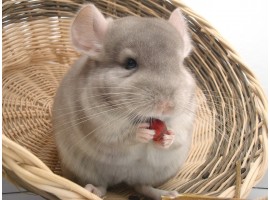What can the chinchilla tail tell us?
Tail Tips
If you’ve ever wondered why chinchillas have such a long tail, here are some useful tips. All chinchillas have a long and very strong tail compared to other rodents. This is because chinchillas are especially fast in jumping and use their tail for balance. Without such a tail, the sense of balance would be greatly affected, and the chinchilla would not be able to move as elegantly as usual.
Chinchilla tail is a direct continuation of the spine and provides important information about the condition of the spine of the animal. And if the beast has a strong tail, it is likely that the entire structure of the skeleton is healthy and strong.
In addition, the tail of the chinchilla gives an idea of the emotional state of the animal. The position of the tail and the position of the hair provide important information about the anxiety, illness and other emotions of the chinchilla. The owner who regularly watches his animals learns to recognize and explain these signs.
Another source of information is the tail in terms of fur color. Only a few days after the birth of the calf, the final color of the individual can be determined on the underside of the tail. However, some experience is needed to interpret all the information that the tail of a chinchilla provides us.
Spinning tail at chinchilla
Some chinchillas from a young age have a so-called curled tail. The curled tail, as the name implies, is constantly twisted like a pig. However, this symptom does not affect the life and development of the animal. Chinchilla does not have any flaws in its daily movements.
This property is undesirable in breeding chinchillas on skins, since the tail falls on the back of the back and thereby permanently damages the fur. However, for breeders and lovers of chinchillas like us, this does not matter. Even in many valuation exhibits, curled tail does not play any role in the award of points.
Finally
Everyone who wants to engage in their own breeding should learn about these features of animals from experienced chinchillovodov or from books. And also be sure to personally observe and compare the animals themselves. No book is able to replace these comparative values and personal experience.
We hope that we have revealed a little the features of the anatomy and behavior of chinchillas. Read also other publications about these incredible animals.
Popular Articles
What can the chinchilla tail tell us?
Tail TipsIf you’ve ever wondered why chinchillas have such a long tail, here are some useful tips. All chinchillas have a long and very strong tail compared to other rodents. This is because chinchill..
Bee ointment recipe
On the basis of the dead bees, which inevitably exists in any apiary, I prepare a universal ointment for "all diseases". In this article, you will find a simple recipe that has been passed down from g..
Top 20 Names for Chinchilla Girls
CherieMasyaSimkaRosetteBiancaFluffSpoolNyashaOlivePampushkaPrincessSpoonYasyaFIFABasiaIgrulyaHrumkaKseniaLucyAlice ..
Bipin-T instruction
Bipin-T is a solution for the preparation of an emulsion for external use. The main active ingredient is amitraz 12%Mode of applicationBefore use, 1 ml of the drug is diluted in 2 liters of warm water..




